Posted by David R.E. Hunt on 01-13-2003 05:19 PM:
Timuri Camel Ground Prayer Rug?
To All - About a year ago I was making my usual rounds through the
antique/junk shops of Frederick, Md., always on the lookout for antique
furniture as well as rugs, when I happened upon what I believe to be an
interesting prayer rug of the now recognized as heterogenous yet for so long
undifferentiated and hence for all practical purposes homogenous Balouch
variety. I spied it from twenty feet away and after having examined it for
thirty seconds I KNEW I had to buy this rug. Granted, under normal lighting this
rug looks dark and dingy, yes it's worn, but you could spend more for a pair of
moderately expensive athletic shoes so I went to the counter, all the while
hoping that the clerk wouldn't either notice that my face is about to split open
from grinning, or say "Whoops, that's the wrong price". After having recovered
from my adrenaline rush, I realized that being on a budget such as we are, my
wife in all her old world glory and irrespective of the fact that she has spent
more on phone calls home since we have been married than I have spent on my
entire collection, might visit bodily harm upon my purchase, so I hid it in the
attic amongst my other rugs. I took it out one day when the wife was gone and
pinned it to the side of my utility shed and took a couple pictures with my web
cam (am still new to this computer stuff but getting there) and submitted them,
along with my grand eloquent sortie into creative writing disguised as didatics,
to Turkotek and was pleasantly surprised by the response. I'm sorry to say that
I still haven’t taken it down to a rug morning at the Textile Museum, but I have
managed to buy my wife a decent digital camera and what a difference it makes in
the quality of photos! The flash brings out the colors, and the pictures really
are pretty close to accurate representation. So this time I will dispense with
the bovine excrementalism and just tell you what I know about this
rug.

The rug
measures in at 36 in. x 63 in. and has ivory warps and dark double wefting, an
extremely flexible handle, almost as of cloth, and has about 10 asymmetrical
left, slight warp offset Kpi horizontil and 14 Kpi verticle. It contains one
small patch near the selvedge and evidence of wear all over, and an upper right
corner near the spandrel which suggests to me foot traffic, but is essentially
complete including the ends and four chord goathair side finishes. There is
considerably more abrasive damage to the lower kelim end and the head and
shoulders portion of the mihrab device, also evidence of some "spread" near the
lower middle of the rug ; yet the pile directly adjacent to the lower end is
some of the best preserved and suggests that this wear may be due to the
relatively fragile nature of flatweave compared to pile and not to prayer use,
and the mihrab wear mearly an extension of the fore mentioned foot traffic. For
myself the handle is the most intriguing aspect of this rug and together with
the overall construction and attention to detail worthy of discussion, as this
handle, so supple and yet so firm, I believe proceeds from the high quality of
the craftsmanship. To think that someone constructed entirely by hand, the
meticulous twining and the minuteness detail of the weave, is telling. The pile
is cropped so thin, the handle so pliable, the construction so meticulous, that
I am led to the conclusion that this is not a "regular" rug and was made to some
specific purpose, either votive, an accoutrement of prayer, as a luxury trade
good, or even all three. I have suggested a tenative attribution of Timuri,
which I base upon descriptions in the literature at my disposal ( limited), and
some interesting affinities in design and construction demonstrated by a Timuri
rug in Opie's Tribal Rugs, a modern Timuri in my possession, and the prayer rug.
In brief, the trademark panel designs of the Timuri and their affinity for tree
designs are demonstrated by all three rugs, as are to varying degrees
the

infilling
of the fields with geometricies, dice flowers, and the lazy "S" motif.
Simularities between borders are demonstrated between Opie and the prayer rug,
and a certain accentuation of design elements, in the case of the new Timuri by
a few yellow or green knots of wool and in the prayer by a few knots of
variously colored silk. These rugs all seem to have a goathair selvedge, and in
the least the two in my possession.
The wool dyes in this prayer rug, in as
far as my limited knowledge allows me to ascertain, seem to be of the natural
colors, in subtle variations of red, green, blue and brown earth tones, perhaps
totaling seven (7) colors. The silk highlights which are a point of important
contention, are of what appears to be an insect red, a mint or teal green,
yellow,a lighter and darker hue of purple, and ivory; six (6) all told.
Silk
highlights are to be found primarily in the figure at the top of the mihrab form
and in various details of the tree of life and fillers in the field.
Interestingly, a single knott of ivory silk is situated at the petal apices of
every dark flower in the floral border. These silk highlights have corroded
almost to the point of nonexistence on

the face of the rug, and the
overall

fading
of the rug from age, wool as well as silk, have taken their toll upon the
colors, yet magnification reveals that these silk colors have changed little
from

the back,
and that the seeming color change proceeds more from contamination by the
foundation colors than real change in tone. I myself am not qualified to make
the determination as to origin of the dye stuffs, be they natural or synthetic.
Much of the green and brown wools are extensively corroded and impart a pleasant
textural effect. There is also a use of cotton in the pile , seemingly limited
to

an amulet or
"bowtie" shaped device at the base of the tree of life. There are also just a
couple knots of an intense turquoise blue to be found in one of the
borders.
What so compels me and what I personally like so much about this rug
are both : (1) the symmetry of the overall composition, as demonstrated by the
trees of

the
spandrels being balanced by the trees at the base of the mihrab, the division of
the mihrab into three distinct regions, composed of a


large semispherical arrangement
at the base, a smaller spherical symmetry in proportion with

the head of the mihrab at the top,
and an opposing spherical symmetry uniting the two, and; (2) that it presents
the most realistic and detailed rendition of the Sylvan paradise that I have
ever seen in a Balouch group weaving and at least suggests that the Balouch tree
of life design could have been inspired by the tree of life prayer format rugs
produced by the Persian manufactories. Yet this of course does not rule out the
possibility of a convergent coincidence. If anyone has any ideas or suggestions,
please feel free to post- Dave
Posted by Steve Price on 01-16-2003 10:37 AM:
Hi David,
Belouch camel-ground tree of life prayer rugs were made by
the tens of thousands (maybe more) during the late 19th and early 20th
centuries, almost entirely for sale outside the tribal communities. Presumably,
many went to Moslems in Iran, but most were sold to the west, where fascination
with the exotic orient was fashionable.
Yours is an especially nice
example, with what appears to be excellent workmanship and materials (the silk
highlights in particular). Some of these use camel hair for the field, some use
dyed wool. The color variation in the field on yours suggests that it is camel
hair.
Silk pile on old rugs is almost invariably lower than the
surrounding wool pile. It is usually described, as you describe it, as being
corroded. I'm not sure that this is accurate. Silk has very poor abrasion
resistance, and wears much more rapidly than wool does. This may account for the
low pile height in silk areas.
Attribution of Belouch group weavings is
not something about which there is general agreement, and there is little
published information on the basis on which to make them. The region where
Belouch group stuff is made is ethnically extremely heterogeneous while the rugs
share a distinctive common aesthetic. I incline not to be more specific than
"Belouch group", although others (Michael Craycraft, for instance) who have
devoted a lot of study to the matter are more confident in subdividing the group
when making attributions.
Regards,
Steve Price
Posted by Yon Bard on 01-17-2003 07:11 PM:
Steve, I believe that the 'lowness' of silk areas is due to corrosion by the
dyes, reather than abrasion. In fact, many areas of silk have almost entirely
lost their pile, hardly the result of corrosion. For the same reason, American
'crazy patch' quilts, usually made entirely of silk, suffer severe corrosion in
areas of certain colors.
Regards, Yon
Posted by Steve Price on 01-17-2003 09:42 PM:
Hi Yon,
I am uncertain about whether the poor abrasion resistance or
corrosion by dyes is the most significant factor in the almost invariably lower
pile in areas of silk than of wool.
I suppose one way to try to tell
which is more important is to see whether the silk pile is low in every color or
only in areas with one or two specific colors. It seems unlikely that
every dye is corrosive to silk, so if there are several colors of silk
and all of them are low, abrasion is probably the more likely explanation. I
don't think I've ever seen an old pile weaving with silk and wool in which the
silk pile is as high as the wool pile, but my memory is not so reliable that I'd
bet my life on it.
I have an old Belouch "bird" khorjin with scattered
silk knots in yellow-gold, and all of them are low. I also have an old Tekke
juval face, a Tekke ak-juval and a Tekke mafrash, all with the usual Turkmen
magenta silk, and the silk is much lower than the wool in all three. I don't
think I have anything with silk pile dyed with green or blue,
though.
There are some all-silk Persian rugs around from the 19th and
early 20th century, that have many colors intheir palettes. Do you know whether
these generally show particular colors more worn than the
rest?
Regards,
Steve Price
Posted by Yon Bard on 01-17-2003 10:15 PM:
Steve, I think both silk and cotton are less resilient than wool, therefore
both will feel somewhat low even without corrosion. But when you see silk areas,
usually the purple ones, that have practically lost all their pile in a rug that
otherwise shows little wear, I think it can only be due to corrosion, either
from the dye itself or some associated chemicals, such as the
mordant.
Regards, Yon
Posted by Steve Price on 01-17-2003 10:36 PM:
Hi Yon,
Cotton has very poor resilience, and is often low just from
being matted down (as you note). And while you may be correct about the low silk
being that way as a result of corrosion, I'd be more comfortable about it if
someone can attest to knowing that it is a phenomenon specific to a few dyes.
The corrosive black-brown dye that affects wool in so many 19th century
(and earlier) rugs may be a good analogy. Many old rugs with almost no
noticeable wear will have the blacks or browns corroded down to (or close to)
the foundation. The fact that the pile dyed with other colors is not as low
tells us that the effect is corrosion (or some other process that specifically
reduces the abrasion resistance of wool dyed with it). When a wool rug is evenly
low in all colors, obviously, the cause is abrasion.
Regrds,
Steve Price
Posted by Marvin Amstey on 01-18-2003 12:22 PM:
'morning Yon and Steve. I thin that you are both correct. Silk easily
abrades, and certain colors are corrosive - perhaps moreso on silk than wool. If
you rub you finger nail against old silk pile, some color will come off
(actually the fibers are torn off) onto your nail. I have a Baluch saddle cover
with green silk which has been abraded as much as any other silk color in the
piece.
Regards,
Marvin
Posted by Unregistered on 01-18-2003 07:26 PM:
SILK
Hi Dave and all,
When natural dyeing became unprofitable the secret
recipes became public. Hundreds of them. Unfortunately the biggest secret
revealed was in the mordanting. Proto-scientists loved working with metals. The
complexities of coordinating covalent bonding, which was pretty much required
for making economically feasible wonderful dyes, was obtained, for certain
dyestuffs, by dumping vast quantities of lead into mordant baths.
Protein fibers are very receptive to heavy metals but silk is especially
weakened by them. Madder red is seldom seen on silk rugs. This is probably
because madder dye mordants and dye baths had huge amounts of mercury dumped
into them. Silk hates mercury. Even if dyed without being mordanted, as was a
common practice with cochineal and other dyes which don't absolutely have to be
mordanted, silk was commonly weighted by manufactures with metallic baths as it
was sold by weight.
I don't think that iron would be used to dye silk
because if brown was wanted one could buy Tussah silk. Tussah silk worms will
only eat mulberry leaves which are high in tannins and this dyes the silk as the
silk worm spins it's cocoon . Many shades of natural Tussah were
available.
Another problem with silk as a rug material is that while wool
"fulls" silk "blooms". It is possible that the silk knots in Dave's rug were
clipped shorter than the wool, from the get go, to compensate for this. The
longer wool pile could then slightly shelter the more fragile silk while also
containing it from "overblooming" before the wool "fulled" enough to stop the
silk from defusing the rug's patterns. This is a guess.
Another problem
with silk is that it has a very low UV ray toleration. Too much sun and silk
will begin to disintegrate before the dye has had a chance to fade. Although
chrome mordants can protect fiber from this silk hates chrome. Silk also hates
copper, which is used in wool for greens, etc. Silk takes dyes wonderfully but
is very, very picky. This I know.
Dave, please try to find two areas on
your rug which have the same amount of wool wear but with one area's wool more
faded than the other's. Both areas chosen should have both ivory and dyed, (same
color), silk within them. Beg, borrow, or steal a a jeweler's loupe. You will
need good lighting. Try to determine differences in the silk. Check the silk for
color fading, knot length, and abrasion vs. corrosion of the fiber ends. As this
can help eliminate or pinpoint UV damage, etc., as factors it would be nice if
other's would do this with their rugs, too. I think we all could learn some
things by such a comparison. Sue
Posted by Patrick Weiler on 01-18-2003 07:33 PM:
It makes good underwear, though
Marvin,
I remember visiting an antique rug dealer one day when a Big
City rug dealer was visiting town, looking for rugs to buy. He was intently
examining an old, silk prayer rug with a lovely 3" long fringe. Suddenly he
yanked a couple of the fringe pieces right out of the rug. The startled rug
dealer was visibly taken aback. The buyer said that if the fringe broke off
readily, it was really silk (as opposed to mercerized cotton, I suspect).
He
did not buy the rug, but was convinced that it had silk warps!
Patrick
weiler
Posted by Steve Price on 01-18-2003 09:57 PM:
Hi Sue,
Would you be good enough to send me your family name? I'd like
to edit your very informative post to include your full name. We prefer for
people to do so, as we believe that it helps to maintain the civility of our
discussion boards if everyone at least knows everyone else's
name.
Thanks,
Steve Price
Posted by Sue Zimmerman on 01-19-2003 03:27 AM:
SILK
Hi Steve,
Oops. Sorry about that. I forgot to type in my name on my
last post. Also, when I was talking about silk as a rug material I forgot to say
that I was referring to spun silk which is used for knots and sometimes wefts.
Reeled silk, which is what is used for warps, is a very different story. Sue
Zimmerman
Posted by Steve Price on 01-19-2003 10:15 AM:
Hi Sue,
Can you expand a bit on the different forms of silk, their
properties and uses?
Thanks,
Steve Price
Posted by Sue Zimmerman on 01-20-2003 04:43 AM:
SILK
Hi Everyone,
Before I elaborate on silk, a few things.
I see I
said Tussah silk worms eat only mulberry leaves which is high in tannin. Not so.
It is the Bombyx silk worms, the cultivated ones with the whitest silk, that
will eat only mulberry leaves. Mulberry leaves are LOW in tannin. I'm sure you
figured out that this was a mistake but I must clarify.
Yon, I have been
ruminating about what you said about the purple silk knots. Do you know whether
they were dyed with cochineal, madder, or indigo over-dyed with cochineal? Were
the rugs Turkoman? I have only seen cochineal used for red or lavender silk in
them but not purple. If you know that it would really help narrow things down a
bit. It may be key.
I have extrapolated what I have learned about Indian
cooking into a silk yarn dying system. Has anyone seen how old "No expense
spared" type Indian rug silk has fared? I would really appreciate reports of
this.
Lucky for me a lot of information about silk is free for the
searching. The silk biz is very labor intensive. You either have access to cheap
labor or you don't. No secrets there. You either can afford cutting edge
equipment or you can't. No secrets there either. Even so it is still a
competitive business. There are good years for silk quality and there are bad
years. If you are in the market to buy silk you can learn a lot just from sales
pitches. Some of the problems of the past, such as weighing silk with tin salts,
can now be avoided. Some of what I have learned can help with the understanding
of silk history and it's production but if you want more of that you can easily
find it. Except maybe from the East India Co. I've given up on
them.
Bombyx is the smoothest, shiniest, and whitest silk. It has been
under cultivation for who knows how long. The caterpillars eat chopped mulberry
leaves which is brought to them 8 times a day. Each one will eat about 60 pounds
of leaves before spinning it's cocoon. They cannot fly. Midway through their
metamorphosis they are smothered to make sure they don't have a chance to emit
enzymes which disintegrate a circle in their cocoon from which they could
otherwise have emerged. This is done because silk is created as a continuous
fiber and it's tensile strength in warps is mostly dependent on it's being
continuously unwound from the cocoons. Only the most perfectly formed, in size
and shape, blemish free cocoons can be reeled for warp usage. Once the gummy
protein sericin, the cocoon's binding medium and UV ray filter, has been boiled
off cocoons are unwound together and the sericin is reapplied to bind the
filaments, temporarily, as they are tightly twisted then plied for warp. This is
called "organzine" reeled silk. "Tram" reeled silk has less of a twist and can
be used for weft.
Nonperfect cocoons and unreelabe parts of the perfect
ones are simmered, a hole is made in them and the caterpillar is removed.
Sometimes the cocoons are stretched out over a form into "caps". The caps are
stacked into a "bell of caps". A bell of caps, weighs a pound, and consists of
about 1,600 cocoons. Other times cocoons are stretched into flat "Hankies" for
hand spinning from the fold. Silk roving is made by caps which are stretched out
into a smoke ring shape and then cut and separated lengthwise. The roving is
often cut into 3 inch sections for spinning either alone or with different
fibers. Unspun roving could possibly be used for knots so I'm sure someone has
done it.
There are sheep and there are goats. The goats of the silk worm
world are the Tussah silk worms. They have resisted cultivation in captivity.
They eat a variety of leaves with varying amounts of tannin content. Their
cocoons are supposedly collected after they have flown away. There is no reeled
Tussah silk, supposedly, because of the hole left in the cocoons. Their silk is
slightly stronger and more coarse than Bombyx. Tussah silk is much easier to
spin.
There are hundreds of other silkworms. The only other one I can
think of that might be used in rug production is called "Douppions". Well, I
doubt it, but it's so weird I just have to tell you. Douppions spin that slubby
Shantung silk. This silk happens because two Douppions spin one cocoon
together.
The innermost part of cocoons is called "noil". I call it junk.
Noil is nubby and inexpensive. It is used in specialty yarns for texture, silk
sweaters, etc. I don't want to talk about it because it sickens me. I'll just
say it has a smell when wet that some people like.
Then, of course, there
is the innermost byproduct of silk production. It is called "silk protein". It
is used as food by some people. Maybe silk worker rations. You might be thinking
"I would never eat that". In the 1940s a gelatin dessert became famous. The red
variety was colored with a natural flavoring. It was cochineal. Essentially this
famous dessert was sugar, rendered hoofs, and bug juice. It's probably is worse
now.
Reeled silk is not suitable for pile in rugs. It is very slippery
and tends to unknot itself. the mistake of exposing all those tiny unspun fibers
would be immediately apparent. I'm sure that it was sometimes done anyway by
someone.
One more thing. Today top quality spun silk is "gassed". I did't
ask why this name was chosen. This process consists of running the yarn past
needles which emit an electric charge which makes all the free ends of the fiber
stand out. The yarn is then run by a flame which singes off the fluff. In the
past pilling could have been another silk problem. In silk a tighter twist means
less pilling. Plied silk yarn pills less than singles. Sue
Posted by Yon Bard on 01-20-2003 09:15 AM:
Sue, the rugs are Turkmen. I don't know what dye is used, but the purple
color is pretty standard for silk highlights in Turkmen rugs, and they are
nearly always highly corroded. Three-gul Salor chuvals are typical of pieces
that have this feature.
Regards, Yon
Posted by David R.E. Hunt on 01-21-2003 07:57 PM:
Silk and More
Dear Steve, Sue, and Al l - Thank you so much for the kind words about my
rug. It was almost as much a question of luck and fate as recognition, my
finding this weaving, as under normal room lighting it looks rather gloomy. It
was the camel ground format and knowing that Belouch pieces can often require a
strong light to bring out their colors that cinched the sale, exuberance of the
design aside. Being a champion of the chronology theory, and being impressed by
the detail of the paradise scene depicted in this tree of life mat, I have
searched (and none too diligently I might add) for companion pieces by which to
confirm the belief that I might have in my possession a particularly early
version of the Balouch tree of life format to no avail. The lack of published
examples of such a popular weaving format which can be dated prior to the last
quarter of the 19 th cent. suggest both that the inception of the Balouch prayer
tree format dates from this time period and that both florid and abbreviated
versions of the same design can and are produced during like time periods. As
for the silk, I've gone back and taken another look, and it seems that all of
the silk has degraded. The red has fared the worst, and some knots are
completely gone, while the purples don't seem to vary much, even from worn to
relatively unworn areas. It seems that the green and yellow have fared the best,
and while they have faded a little in color, not out of proportion to the rest
of the rug. And I have to admit that the cotton seems as much matted as worn.
Well, this is my one that didn't get away, and underscores for me the importance
of keeping my eyes open and remembering that decent rugs can be found almost
anywhere. If only I could have the ones that got away! -Dave
Posted by Sue Zimmerman on 01-22-2003 12:57 AM:
Silk
Thank you, Yon!
I suspected those were the rugs you meant but didn't
know that those places where something obviously went very wrong were supposed
to have silk knots in them. Now I know. The photos in books I have do not home
in closely and sharply enough to allow me to find even one good example of the
color, unless I am missing it. I will look again. This may be because I have
dyed silk in concentrated cochineal baths and it doesn't look like anything I
have seen yet in rug books. I don't have the means to see such rugs in person.
It might be that I am one of the few people who has, in hand, samples of what
deep purple dyed silk pile looked like in new Turkmen rugs.
For those who
don't know, here's some things. Cochineal can go crimson with alum, scarlet with
tin, lavender with chrome, and purples are had with any of the aforementioned
plus iron. It's a pH thing. There is more to it, of course, but add acid for
oranger, brighter colors. Add ammonia, etc., for bluer, violet tones. Take two
skeins of silk yarn mordanted and dyed together in the same cochineal bath.
Adjust one of the skein's pH upward in a post-dyebath dip and you can see that
the colors are different but the value of the colors will be the same. If you
dye two skeins in a very saturated cochineal purple bath and then give one a
brief dip in a tin afterbath, that one will go rosier. This is called
"brightening" but I think of it as bleaching because it's value goes way down
the scale to pastel territory. Even worse the luster is lost and the silk turns
brittle. It is killed. At least it happens with the form of tin I used. I won't
be trying stannous chloride, the recommended form of tin, as I know of a
ceramist who went blind from it's fumes. I haven't seen this problem addressed
but it's there. Madder purples have their own variables, as do other reds. If
you don't have a good eye for color you will, if you experiment with the
variability and subtleties of natural dyes, at least as far as color pertaining
to rugs is concerned. It's quite something for that.
Although cochineal
gives wonderful high pH purples with alum mordant I rejected it for my own use
because reacidification heroics to bring back the luster were futile. The silk
died of multiple injuries. Maybe in the future some electronic means will be
invented for silk resuscitation. For now, it's R.I.P. for cochineal silk dark
purples as far as I can see. Reeled silk, always a different story, seems much
more capable of withstanding such treatment. I rejected it, too, because of the
"it's just a matter of time" factor.
The only book I have that is not a
general rug book is 'Between the Black Desert and the Red'. It is a wonderful
collection. My copy of the book was printed upside-down and backwards and the
pages fall out. I'm glad because otherwise I could not have afforded it. What
would be the frontispiece, on perfect copies of this book, reveals that
cochineal dyed silk is capable not only of maintaining it's grasp in it's grid
but needn't decay before the rug does. Not only has it fared better than the
black corroded wool it is adjacent to, but the juxtaposition of the "bloomed",
comparatively long, silk pile and the "fulled" wool is stunning, in my opinion.
I think that much of the red wool in this trapping's dye includes cochineal, or
more likely, was given a cochineal overdip as the picture of the whole rug,
plate 4, includes some more-orange madder pile of the same value. That's a guess
also based on the fact that a lot of rugs which use both cochineal and madder
lack this one's color harmony. They clash.
Although the books authors are
not into descriptions of qualities, wear of materials or much on how colors were
obtained, or when the rugs were made, they do tell numbers of plys and general
color information of the silk knots used in the rugs so further study is
possible. I will do this.
I speculate that for deep purple colored silk
knots the less pH temperamental slippery reeled silk was used. If this is the
case most of them, weakened and probably thinned to the point of no longer
fitting tightly, could very easily have unknotted themselves. They would also
have been much more susceptible to abrasion than spun silk due to so much more
surface exposure. They probably ended up in post-Turkman owners vacuum cleaner
bags, enmasse. It looks like this might of happened to the Salor chuval in Plate
2. This bag stirred up memories of many other ones with whole missing areas of
pile which, Yon informed me, once had silk pile. I will go through my books and
find them all. It will be sad.
There is a purple dye to be had with
madder that requires mordanting twice, once with iron and once with alum. The
wool is then dyed with madder and tannin. A recipe for eventual oxidation
disaster for wool and a very quick one if used on silk, I'm sure.
Do any
of the early tribal rugs with the really good deep colors include silk knots? Do
their deep brownish colors show the iron wool corrosion that so many later ones
do? To me, in my books, they look better than later ones. Did they use dark
wool? Has anyone seen them in person? I'm wondering.
There is another
possibility which I haven't seen mentioned. Anywhere. It may be that some of the
really good deep dyes on early Turkmen rugs were overdyed with Brazilwood. I
know it is fugitive but have read that used in conjunction with madder it fades
to a brownish red and somehow stabilizes, or, at least, fades true. It was so
popular, once upon a time, that a country was named after it. I will buy some
Brazilwood and test it. I will also test some other reds from stuff I haven't
seen mentioned in rugdom. Maybe I will report back with further findings. If I
do it will be posted in the Turkotek rug related topics area as I have no
camera, computer camera, or scanner.
Once again, thank you very much for
your help, Yon! Sue
Posted by Yon Bard on 01-22-2003 08:45 AM:
Sue, if it's of any help I'll post close-ups of corroded silk areas either
later today or tomorrow.
Regards, Yon
Posted by Yon Bard on 01-22-2003 01:57 PM:
Turns out that these highly corroded silk areas were motly crimson-type of
colors, not purple. Here are some images:
1. A salor trapping

2. Ersari chuval
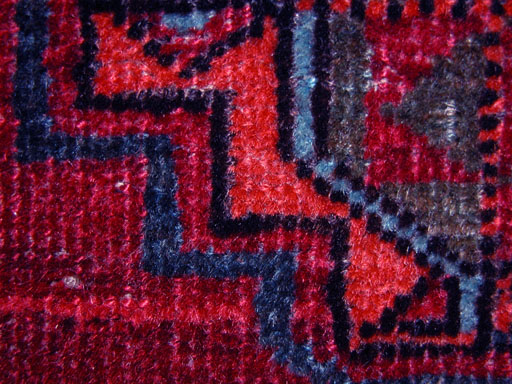
3. Saryk
chuval
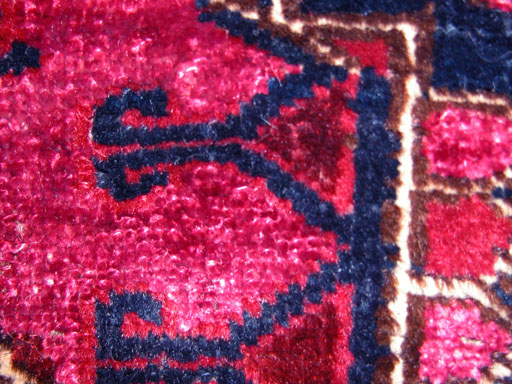
4. Another Saryk chuval
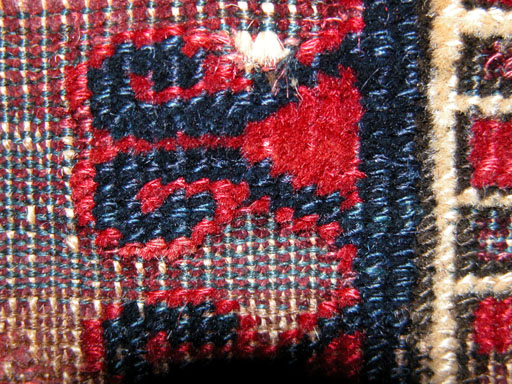
5.Tekke mafrash (the only
example where the pile is still there, but much lower than the surrounding
wool
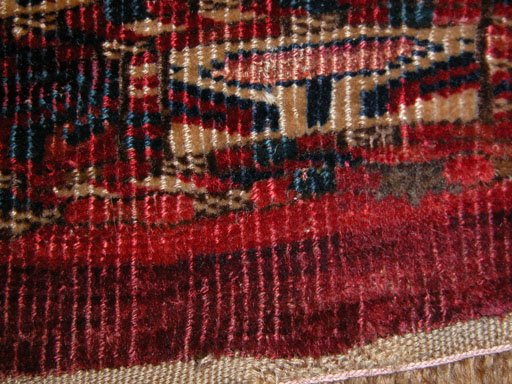
Regards, Yon
Posted by Kelvin_Webb on 01-23-2003 08:34 AM:
Sue,
Regarding the following from your 1/22 post:
"Do any of
the early tribal rugs with the really good deep colors include silk knots? Do
their deep brownish colors show the iron wool corrosion that so many later ones
do? To me, in my books, they look better than later ones. Did they use dark
wool? Has anyone seen them in person? I'm wondering"
These two images are
part of a first half 19c Turkmen rug and have a deep brown which I believe is
natural/undyed.
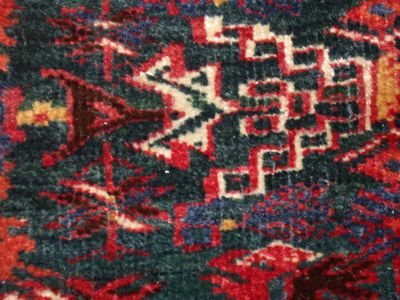
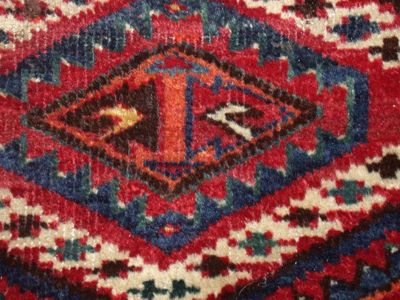
Looking at the structural analysis in the back of the book
"Turkmen" I had noticed that several early Yomut rugs have an 'undyed
brown'
Kelvin Webb
















